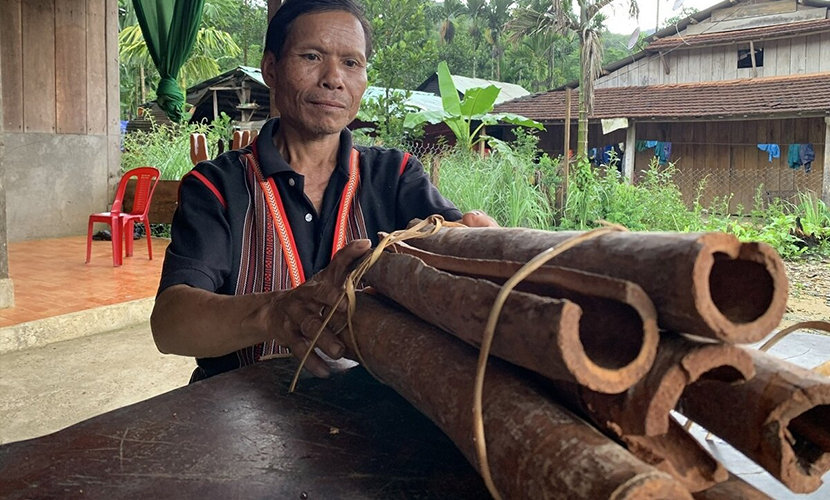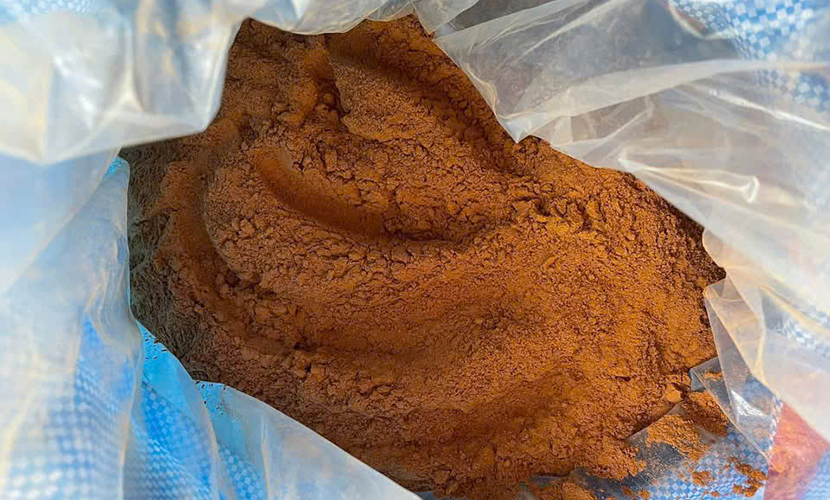
“Tra My cinnamon carries the gentle fragrance of the forest.” This crop originates from the cinnamon trees and their renowned products, which once brought fame to Tra My district. Vietnamese cinnamon cultivation has now been gradually introduced to many mountainous districts across Quang Nam province. It is steadily becoming a key agricultural product that contributes to poverty alleviation among highland communities.
Tra Don and Tra Vinh are two remote communes of the mountaineous district of Nam Tra My. For many years, local residents have shifted from planting acacia to Vietnamese cinnamon cultivation, intercropped with cassava. They earn tens of millions of VND per hectare each year from the sale of cinnamon seeds.
Ms. Ho Thi Kim, who lives in Hamlet 3 of Tra Don commune, Nam Tra My district. Her family has reforested barren land with Vietnamese cinnamon cultivation. This is a medicinal plant currently being promoted by local authorities for widespread cultivation. At the same time, she collects fresh vegetables from local residents and sells them to traders in the district.
“With the profits from farming and trading, I continue to invest in planting cinnamon. So far, our family has 10,000 cinnamon trees, which serve as our long-term livelihood. In addition, they create additional jobs for local workers,” Ms. Kim shared.

Vietnamese cinnamon cultivation
A Lang Min, is another farmer, from B’hong Hamlet, Song Kon commune, Dong Giang district. After harvesting nearly one hectare of cinnamon, his family earned hundreds of millions of VND. Therefore, his family decided to expand their Vietnamese cinnamon cultivation area. They hope that the crop will bring them a more prosperous life.
Mr. A Lang Min said: “In B’hong Hamlet, almost every household grows Vietnamese cinnamon. Last season, my family planted more than one hectare and sold it for over 80 million VND. This year, we are planting another 1,400 trees because I see that cinnamon has greater economic potential than other crops.”
Mr. Dinh Van Bao is the Vice Chairman of the Dong Giang District People’s Committee. According to him, the district has introduced a range of policies to encourage and support local residents in shifting from growing raw material trees, particularly acacia, to cultivating large timber forests. Among them, Vietnam’s cinnamon tree is one of the most economically valuable crops. Currently, the district has around 500 hectares of Vietnamese cinnamon cultivation.
“The district emphasizes the transition toward higher-value crops and the development of large timber forests. The province has assigned the district an annual target of 800 hectares of new forest plantations. Of which, there are about 400 hectares have already completed, mostly cinnamon,” said Mr. Bao.
The district is encouraging households for Vietnamese cinnamon cultivation, as it offers greater economic returns. This initiative also helps improve livelihoods while promoting sustainable poverty reduction.

Cinnamon sticks from Vietnam
Ms. Nguyen Thi Hong Le is the Director of the Tra My – Minh Phuc Cinnamon Cooperative in Bac Tra My district. In 2021, the cooperative invested over one billion VND in a cinnamon essential oil extraction system.
“To ensure a sustainable supply of raw materials, the cooperative has partnered with two farmer groups, comprising 26 households. Together, they cultivate a total cinnamon area of more than 56 hectares. At the same time, the cooperative has researched and developed over 20 additional products. They include cinnamon powder, massage oil, cinnamon barks, and cinnamon soap,” said Ms. Nguyen Thi Hong Le.
Also focusing on deep processing, Thai Hoa Cooperative in Tra Tan commune has produced cinnamon essential oil lamps. They have been recognized as a provincial three-star OCOP product. Meanwhile, Ngoc Que Agroforestry Cooperative in Tra Giap commune has developed cinnamon wood plate products.
Many other cooperatives produce cinnamon incense, cinnamon chopsticks, cinnamon tea bags, and floor cleaners. The district has provided support in trade promotion, enabling these products to reach e-commerce platforms and connect with businesses. This assistance has also helped expand market access and strengthen their brand presence.
Vietnam’s cinnamon is not only a high-quality commercial product but also deeply intertwined with the spiritual life of ethnic communities in the highlands. For many ethnic minority families in Quang Nam province, Vietnamese cinnamon cultivation area is a valuable family asset.

Cinnamon powder from Vietnam
Beyond its economic role, Vietnamese cinnamon cultivation helps protect the ecological environment by increasing forest coverage and preserving soil and water in hilly areas. It also contributes to the conservation and development of rare native plant genetic resources.
The cultivation and processing of cinnamon have established it as a key crop with high economic value. It supports stable livelihoods, encourages permanent settlement, reduces poverty, and creates sustainable employment opportunities for local communities.
With an average selling price of around 60,000 VND per kilogram, each hectare of cinnamon can generate an income of one billion VND. Compared with other crops, cinnamon offers additional advantages. Beyond harvesting the bark, farmers can also sell the trunks and leaves to processing facilities, maximizing the plant’s overall value.
It can be affirmed that cinnamon is becoming one of the key crops driving household economic development. Vietnamese cinnamon cultivation plays a significant role in helping highland communities in Quang Nam province eradicate hunger and reduce poverty.
Vietnamese source: https://baodantoc.vn/mo-loi-thoat-ngheo-tu-que-1718105430554.htm
